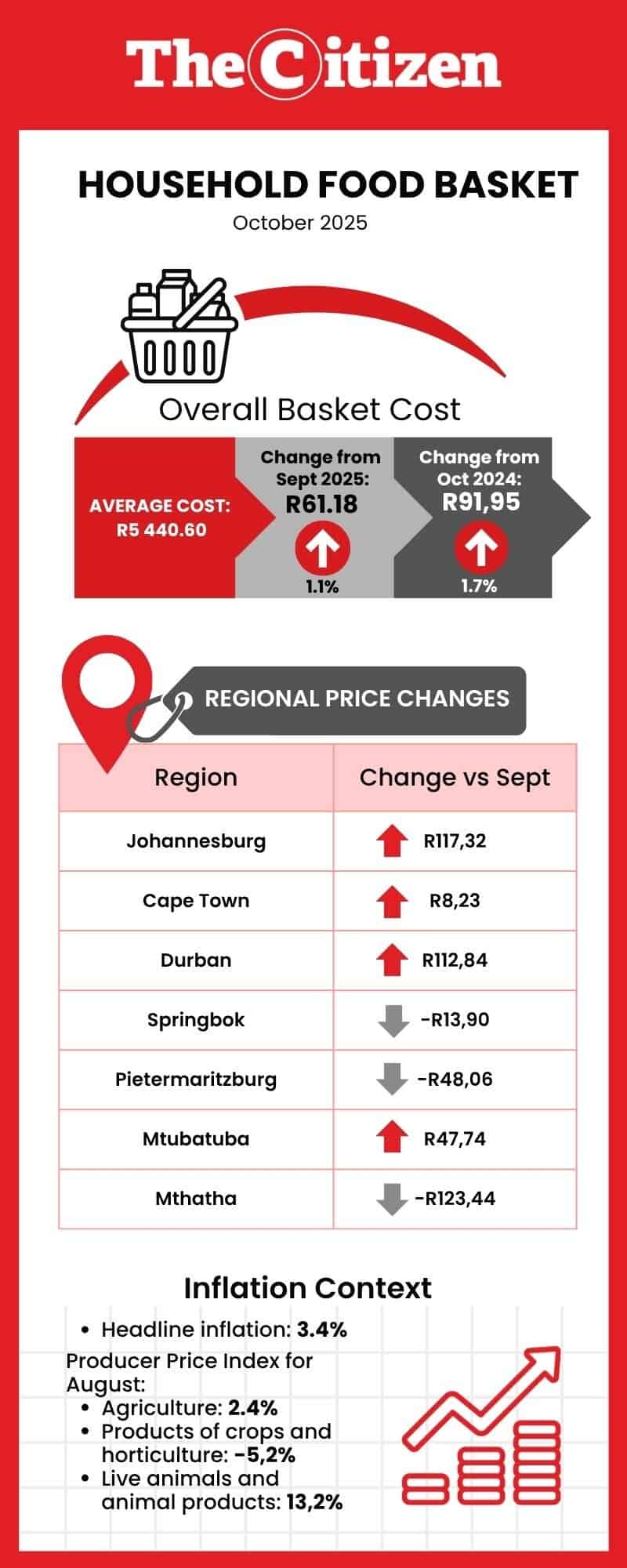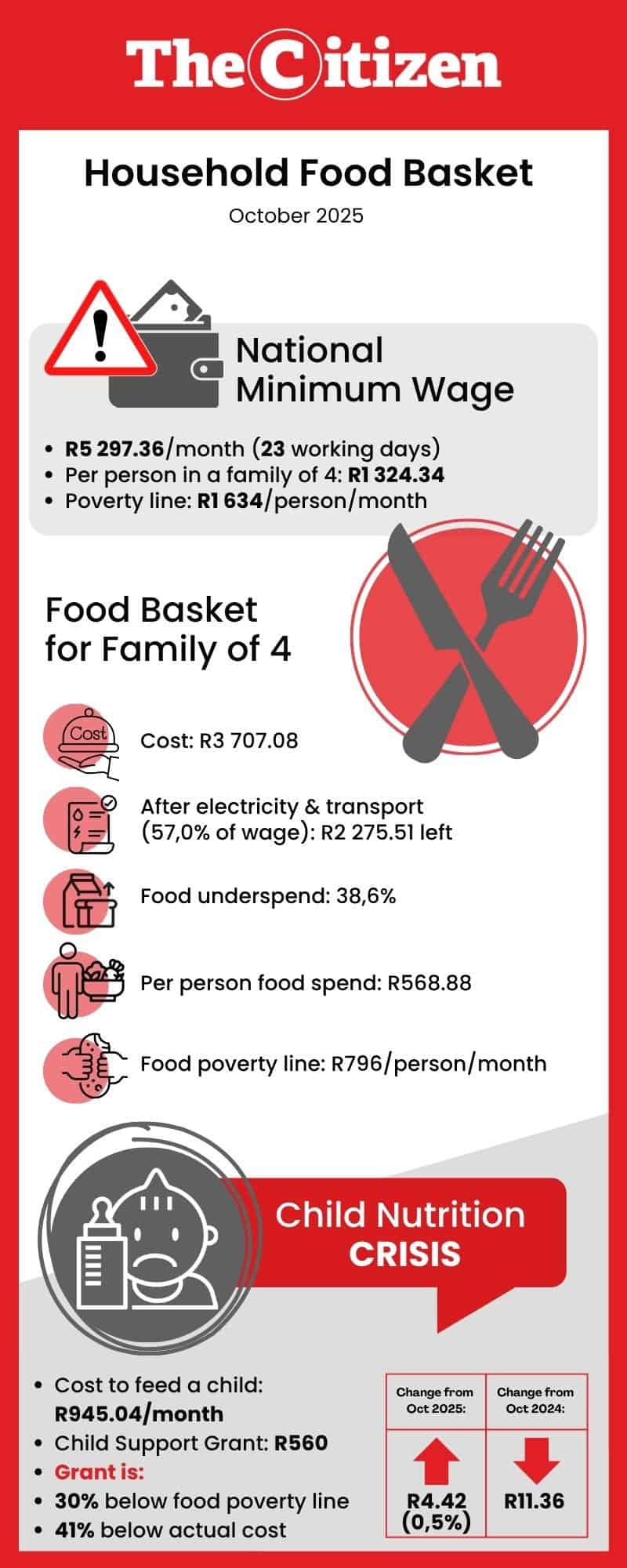While most of us already battle to make ends meet, low-income consumers have to cut nutritious food from their household food basket.

The average price of the household food basket increased again in October, forcing low-income consumers to buy less nutritious food.
The extra R61 that low-income consumers must fork out now seems not much, but it could buy four loaves of white bread if there is nothing else to eat.
The household food basket survey is conducted by women from low-income communities who check the prices where they shop for their own families for the Household Affordability Index. The women track the prices of 44 basic food items from 47 supermarkets and 32 butcheries in Johannesburg, Durban, Cape Town, Pietermaritzburg, Mtubatuba (Northern KwaZulu-Natal) and Springbok (Northern Cape).
The household food basket survey for October shows that the average cost was R5 440.60, R61.18 (1.1%) more than in September and R91.95 (1.7%) more than in October 2024.
The Pietermaritzburg Economic Justice and Dignity Group coordinates and analyses the results of the survey for the household food basket.
ALSO READ: Inflation slightly higher in September, with meat at highest rate since 2018
More than half of items in food basket became more expensive
In October, the group found that 26 of the food items in the basket of 44 products increased in price, while 18 cost less. Notable increases were found in the prices of white sugar, frozen chicken portions, tomatoes, butternut and oranges, while onions, sugar beans and maize meal (except in Joburg and Durban) moderated the increases on the basket.
This graphic shows the increases and decreases in the prices of the food items:

ALSO READ: Food Security Index: slight improvement, but people still going hungry
Prices of household food basket varies from region to region
The average price of the household food basket also varies across regions. This graphic shows how the prices varied from region to region:

Statistics South Africa’s latest Consumer Price Index for September 20251 shows that headline inflation was 3.4%, while the Producer Price Index for August shows that agriculture was increased by 2.4%, with products of crops and horticulture at -5.2% and live animals and animal products at 13.2%.
ALSO READ: Lower diesel price unlikely to ease pressure of food prices for hungry consumers
National Minimum Wage
Prices like these make it very difficult for low-income consumers to afford nutritious food and everything else a family needs. The National Minimum Wage is R28.79 per hour, R230.32 for an 8-hour day and R4 836.72 for an average 21-day working month.
In October, with 23 working-days, the maximum National Minimum Wage for a general worker was R5 297.36. However, this wage must not only sustain the worker, but also the entire family. For black South African workers, one wage must typically support four people.
Dispersed in a worker’s family of four, the wage comes down to R1 324.34 per person, far below the upper-bound poverty line of R1 634 per person per month. With the October average cost of a basic nutritional food basket for a family of four costing R3 707.08 – low-income consumers cannot afford the nutritious food they need.

ALSO READ: Competition Commission’s report shows shocking price increases in SA over past five years
What is nutritious food?
The group says households living on low incomes change their buying patterns in response to changes in affordability conditions. On low incomes, women buy the core staple foods first so that their families do not go hungry and for basic meals to be prepared.
Where the money remaining is short, women have no choice but to drop foods from their trolleys or reduce the volumes of nutritionally rich foods in their trolleys. This has negative consequences for health, well-being and nutrition, the group warns.
As financial and economic circumstances worsen, so too does household health and nutrition. The gap between what women can buy and what they need to buy for proper nutrition widens. The Basic Nutritional Food Basket is an attempt to track the cost of foods required for balanced nutrition, the foods and the cost of these foods for families to ensure their health and nutrition and for children to grow and develop properly.
The basket was designed in consultation with a registered dietician, Philippa Barnard. The Basic Nutritional Food Basket is an index that can be used as a base for a conversation about the cost of nutritious food and the inadequacies of low wages and social grants, the group says.
The list of nutritious food items also ensures that current food expenditure (severely limited by affordability constraints) is not combined with the food expenditure required to secure proper nutrition.
ALSO READ: Groceries still more expensive than last year despite small decreases
No money left for complete household food basket
The group calculates, using Pietermaritzburg-based figures for electricity and transport and the average figure for a minimum nutritional basket of food for a family of four, that electricity and transport will take up 57,0% of a worker’s wage (R3 021,85 of R5 297,36).
Low-income consumers only buy food is bought after paying for transport and electricity, leaving R2 275.51 for food and everything else. Therefore, in October, the group calculates that workers’ families underspent on food by a minimum of 38.6% (having R2 275.51 left over after transport and electricity were paid and with nutritional food for the month costing R3 707.08).
In this scenario, Mervyn Abrahams, programme coordinator at the group, says there is no possibility of a worker being able to afford enough nutritious food for her family. If the entire R2 275.51 all went to buy food, it would provide R568.88 per person per month, again far below the food poverty line of R796 per person per month.
If the low-income consumer has children, the picture becomes even bleaker. In October, the average monthly cost to feed a child a basic nutritious diet was R945.04. Over the past month, the average cost to feed a child a basic nutritious diet increased by R4.42 (0.5%), but it cost R11.36 less than a year ago.
Compare these prices to the Child Support Grant of R560 which is 30% below the food poverty line of R796 and 41% below the average monthly cost to feed a child a basic nutritious diet (R945.04).






